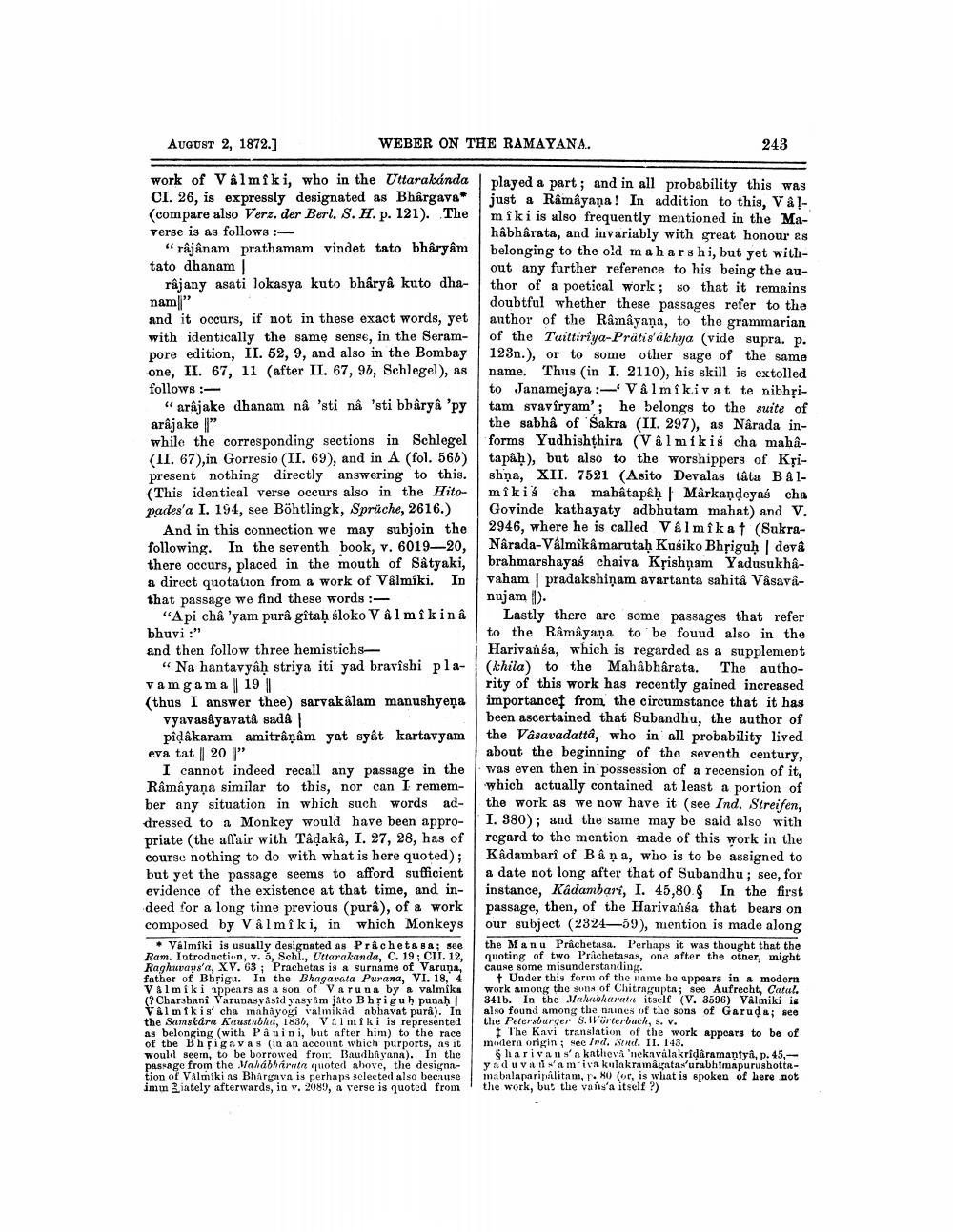________________
AUGUST 2, 1872.]
WEBER ON THE RAMAYANA..
243
work of Valmiki, who in the Uttarakanda CI. 26, is expressly designated as Bhargava* (compare also Verz. der Berl. S. H. p. 121). The verse is as follows:
"râjânam prathamam vindet tato bhâryâm tato dhanam
râjany asati lokasya kuto bhâryâ kuto dhanam and it occurs, if not in these exact words, yet with identically the same sense, in the Serampore edition, II. 52, 9, and also in the Bombay one, II. 67, 11 (after II. 67, 96, Schlegel), as follows:
"arâjake dhanam na 'sti na 'sti bhâryâ 'py arâjake" while the corresponding sections in Schlegel (II. 67),in Gorresio (II. 69), and in A (fol. 566) present nothing directly answering to this. (This identical verse occurs also in the Hitopades'a I. 194, see Böhtlingk, Sprüche, 2616.)
And in this connection we may subjoin the following. In the seventh book, v. 6019-20, there occurs, placed in the mouth of Så tyaki, a direct quotation from a work of Valmiki. In that passage we find these words:
"Api châ 'yam purâ gîtaḥ sloko Valmikin bhuvi :" and then follow three hemistichs
“Na hantavyâh striya iti yad bravishi pla- vamgama | 19 | (thus I answer thee) sarvakalam manushyena
vyavasayavatâ sadå
pidåkaram amitrâņam yat syật kartavyam eva tat || 20
I cannot indeed recall any passage in the Ramayaņa similar to this, nor can I remember any situation in which such words addressed to a Monkey would have been appropriate the affair with Tadaka, I. 27, 28, has of course nothing to do with what is here quoted); but yet the passage seems to afford sufficient evidence of the existence at that time, and indeed for a long time previous (purâ), of a work composed by Valmiki, in which Monkeys
Valmiki is usually designated as Pricheta sa; see Ram. Introduction, v. 5, Schl., Uttarakanda, c. 19; CII. 12, Raghuvans'a, XV. 63; Prachetas is a surname of Varuna, father of Bhrigu. In the Bhagavata Purana, VI. 18, 4 V &lmiki appears as a son of Varuna by a valmiks (? Charabani Varunasyåsid yasyam jato Bhriguh punah Valmiki s' cha mahayogi valmikad abhavat purå). In the Sanskara Kaustubhut, 1831, Valmiki is represented as belonging with Panini, but after him) to the race of the Bhigavas in an account which purports, as it would seemn, to be borrowed fror. Baudhi yana). In the passage from the Vahabharata quoted above, the designation of Valmiki na Bhargava is perhaps selected also because imin Biately afterwards, in v. 2080, a verse is quoted from
played a part; and in all probability this was just a Râmâyaņa! In addition to this, Valmiki is also frequently mentioned in the Mahâbhârata, and invariably with great honour es belonging to the old maharshi, but yet without any further reference to his being the author of a poetical work; so that it remains doubtful whether these passages refer to the author of the Ramayana, to the grammarian of the Taittiriya-Prátis'âkhya (vide supra. p. 123n.), or to some other sage of the same name. Thus (in I. 2110), his skill is extolled to Janamejaya :- Valmikivat te nibhțitam svaviryam'; he belongs to the suite of the sabha of Sakra (II. 297), as Närada informs Yudhishthira (Valmikiś cha mahatapâh), but also to the worshippers of Kțishņa, XII. 7521 (Asito Devalas tâta Bâlmiki cha mahâtape | Markandeyas cha Govinde kathayaty adbhutam mahat) and V. 2946, where he is called Valmikat (SukraNárada-Válmikä marutaḥ Kusiko Bhriguḥ | devâ brahmarshayas chaiva Krishnam Yadusukhavaham | pradakshiņam avartanta sahita Vasavanujam D.
Lastly there are some passages that refer to the Ramayana to be found also in the Harivansa, which is regarded as a supplement (khila) to the Mahabharata. The authority of this work has recently gained increased importance from the circumstance that it has been ascertained that Subandhu, the author of the Vasavadatta, who in all probability lived about the beginning of the seventh century, was even then in possession of a recension of it, which actually contained at least a portion of the work as we now have it (see Ind. Streifen, I. 380); and the same may be said also with regard to the mention made of this work in the Kadambarî of Bana, who is to be assigned to a date not long after that of Subandhu; see, for instance, Kadambari, I. 45,809 In the first passage, then, of the Harivansa that bears on our subject (2324-59), mention is made along the Menu Prichetasa. Perhaps it was thought that the quoting of two Pracheta as, one after the other, might cause some misunderstanding.
t Under this form of the name be appears in a modern work among the sun of Chitragupta; see Aufrecht, Catul. 341b. In the Jahrkarate itself (V. 3596) Valmiki ig also found among the nilines of the sons of Garuda; see the Petersburger S. IVörterbuch, 9. v.
The Kavi translation of the work appears to be of modern origin; sec Ind. Sead. II. 143.
Sharivans'a katheva nekaválakridaramantyi, p. 45,yaduvaaminn kulakraunagatas'urabhimapurushottemabalaparipalitam, r. 40 (or, is what is spoken of here not the work, but the vans'a itself ?)




